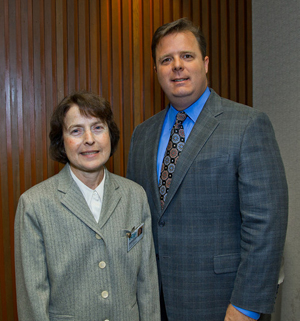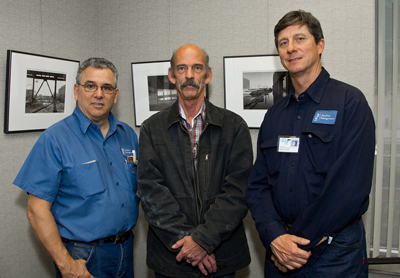UCSF Repeats Impressive Energy Savings
PG&E Awards UCSF $2.7 Million for Reducing Consumption

Angela Hawkins, associate vice chancellor of Campus Life, Facilities and Administrative Services, with Steve Malnight, vice president of PG&E, who presented a check for $2.7 million as incentives for capital projects UCSF implemented under the UC Office of the President's Strategic Energy Plan.
Being a leader in energy efficiency isn’t just a one-and-done exercise. It requires an ongoing commitment.
That’s the lesson from UCSF, which three years ago received almost $2 million in PG&E incentives for implementing energy-saving measures.
PG&E representatives returned to UCSF on April 23 to celebrate another milestone — $2.7 million more in incentives that the University earned for reducing annual energy consumption by 367,000 therms of natural gas, nearly 10 million kilowatt hours and 1.4 megawatts of electricity. That’s the equivalent of avoiding 7,600 tons of carbon dioxide each year or taking more than 1,000 cars off the road.
“You guys are a model because so many people think that is something you do for a little while and then you’ve kind of done everything and you can go away and not come back to it again,” said Steve Malnight, PG&E vice president of customer energy solutions. “There’s always more to do.”
UCSF's lastest success in saving energy is part of a robust sustainability program covering sustainability activities across the entire campus and medical center. Formal and grassroot efforts are happening in many areas of the University. Find out more about UCSF's sustainability efforts at the Living Green website.
Malnight praised UCSF’s energy savings and called it a model way to run its business.
“One of the things to me that is so great about this day is this is a perfect example of why we care about energy efficiency,” he said. “UCSF is a huge part of our community and a huge part of our state. You have an incredibly important mission to move health sciences forward, to train, to learn, to educate, to discover. Everything we can do as an organization to help support you in that mission, we get to feel like at least we were a little small part of the success that you have.”

From left, Robert Basso, chief engineer for Mission Center, Don Carpenter, chief engineer for the Parnassus campus, and Matthew Smith, chief engineer in Capital Programs and Facilities Maintenance, were congratulated for UCSF's energy-saving efforts.
Savings from the past three years came from 60 projects, including upgraded fluorescent lighting, motion sensors in stairwells so that lights are only used when areas are occupied and exhaust fans in parking garages that turn on automatically as needed. Building engineers also added variable speed ventilation to many UCSF buildings throughout San Francisco.
“Before the ventilation was either on or off,” said engineering manager Paul Landry. “That’s like your car always going 60 mph. Now it might be on at half speed or a quarter of the speed.”
UCSF already is planning to retrofit its gas boilers and install more variable speed ventilation systems and more lighting upgrades.
UCSF has a strong desire to be a sustainable organization — and these energy-saving measures help the University do that — but the cost benefits are especially important. The University’s energy-saving commitment has led to savings of almost $1.5 million a year in energy costs.
The energy improvements have also helped UCSF maintain its buildings, many which were constructed long ago. Some of the buildings date to the 1930s and its UC Hall was built in 1917 but is still in use as research labs and offices and houses its ophthalmology clinic.
“Frankly, one of the biggest things is our ability to reduce our costs because then we can use whatever would otherwise be devoted to utility costs we can put toward the mission of our University,” said Angela Hawkins, an associate vice chancellor at UCSF. “That’s a very big deal with all the state budget cuts as we continue to try to reduce our costs.”
Malnight issued a challenge to UCSF leaders to save even more energy.
“I’ve already got the date booked in 2015,” Malnight said. “We want to come back and we want to bring a check that’s even bigger than this one. Does $3.5 million sound good?”
Photos by Susan Merrell